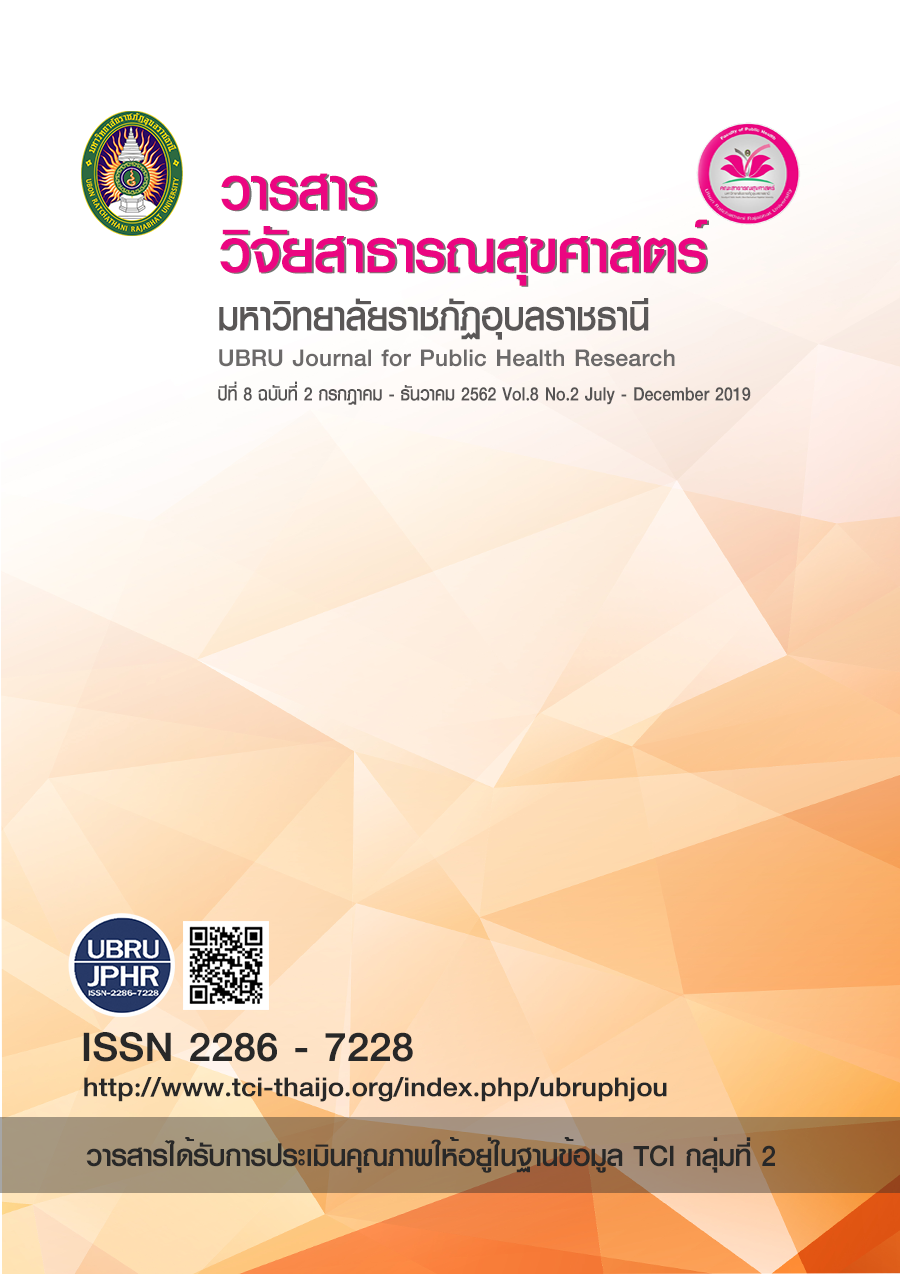การประเมินความเสี่ยงทางสุขภาพจากการบริโภคสัตว์น้ำ ของประชาชนที่อาศัยรอบหนองเล็งทราย อำเภอแม่ใจ จังหวัดพะเยา
คำสำคัญ:
การประเมินความเสี่ยงทางสุขภาพ, การบริโภคสัตว์น้ำจืด, หนองเล็งทรายบทคัดย่อ
การศึกษามีวัตถุประสงค์เพื่อศึกษารูปแบบพฤติกรรมการบริโภค ประเมินความเสี่ยงทางสุขภาพจากการบริโภคสัตว์น้ำ และประเมินปริมาณอาหารที่สามารถบริโภคได้อย่างปลอดภัยเทียบกับค่า Acceptable daily intake (ADI) ของประชาชนที่อาศัยรอบหนองเล็งทราย อำเภอแม่ใจ จังหวัดพะเยา เป็นการวิจัยเชิงประยุกต์ (Applied research) ทำการเก็บตัวอย่างสัตว์น้ำที่ประชาชนนิยมนำมาบริโภคจากหนองเล็งทรายมาตรวจวิเคราะห์ กลุ่มตัวอย่างคำนวณด้วยสูตร Yamane ได้จำนวน 395 คน สุ่มเลือกกลุ่มตัวอย่างโดยการสุ่มแบบง่าย เครื่องมือที่ใช้ในการเก็บข้อมูลด้านพฤติกรรมการบริโภคอาหารใช้แบบสอบถามความถี่อาหารบริโภคกึ่งปริมาณ (Semi-Quantitative Food Frequency Questionnaire: SFFQ)
ผลการศึกษาจากการตรวจวิเคราะห์สัตว์น้ำ 6 ชนิด คือ หอยขม กุ้งฝอย ปลาดุก ปลานิล ปลาไหล และปลาช่อน พบว่าหอยขมมีการปนเปื้อนสารแคดเมี่ยมและตะกั่ว ในปริมาณ 0.0004 มิลลิกรัมต่อกิโลกรัม ส่วนสัตว์น้ำชนิดอื่นไม่พบการปนเปื้อนสารแคดเมี่ยมและสารตะกั่ว กลุ่มตัวอย่างมีค่าการบริโภคสัตว์น้ำที่เปอร์เซ็นไทล์ที่ 90 เท่ากับ 12 มื้อ/สัปดาห์ หรือเท่ากับ 343 กรัม/วัน ในการประเมินความเสี่ยงทางสุขภาพจากการบริโภคหอยขมที่ปนเปื้อนสารแคดเมี่ยม มีค่า Hazard Quotient เท่ากับ 0.0024 และได้รับสารตะกั่วเฉลี่ยใน 1 วัน เท่ากับ 0.078 µg/day ซึ่งมีค่าน้อยกว่าค่า TDI ถึง 2800 เท่า (ค่า Tolerable daily intake (TDI) มีค่าเท่ากับ 3.6 μg/kg body weight/day)
สรุปได้ว่าประชาชนที่อาศัยอยู่รอบหนองเล็งทรายสามารถบริโภคสัตว์น้ำได้อย่างปลอดภัย การประเมินความเสี่ยงทางสุขภาพจากการบริโภคอาหารของประชาชนในพื้นที่รอบหนองเล็งทราย ควรมีการดำเนินงานอย่างต่อเนื่องทุกปี เพื่อเป็นการเฝ้าระวังความเสี่ยงทางสุขภาพของประชาชนในพื้นที่
เอกสารอ้างอิง
สำนักงานนโยบายและแผนสิ่งแวดล้อม. (2561). พื้นที่ชุ่มน้ำที่มีความสำคัญระดับนานาชาติ. [ออนไลน์]. ได้จาก https://wetland.onep.go.th/NongLengsai.html. [สืบค้นเมื่อ 10 มกราคม 2561]
สำนักงานสาธารณสุขจังหวัดพะเยา .(2560). สรุปผลการดำเนินงานประจำปี 2560. พะเยา: สำนักงานสาธารณสุขจังหวัดพะเยา.
Agency for Toxic Substances and Disease Registry (ATSDR). (2007). Toxicological Profile for Lead. [online]. Available from https://www.atsdr.cdc.gov/toxprofiles/tp13.pdf. [cited 20 January, 2017]
Botkin and Keller. (2007). Biomagnifications. [online]. Available from https://dspace.ist.utl.pt/bitstream/2295/50876/1/Saude_riscos_e_toxicologia.pdf. [cited 20 January, 2017]
Codex alimentarius commission. (2006). Joint FAO/WHO Food Standards Programme. Twenty-ninth Session International Conference Centre, Geneva, Switzerland 3 -7 July 2006.
Food Standards Agency. (2007). Front of Pack Nutritional Signpost Labelling Technical Guide Issue. [online]. Available from https://www.food.gov.uk/multimedia/pdfs/frontofpackguidance2.pdf. [cited 20 January, 2017]
Joint FAO/WHO Expert Committee on Food Additives (JECFA) (2000). 55th meeting. Geneva, Switzerland: FAO/WHO, 6-15 June 2000.
Page, N.P. (1994). Human health risk assessment. In Cockerham L, Gandshaned BS(Ed), Basic Environmental Toxicology. Florida: CRC Press, Boca Raton.
U.S. Environmental Protection Agency (2000). Guidance for assessing chemical contaminant data for use in fish advisories, Volume 2-Risk assessment and fish consumption limits 3rded. EPA 823-B-00-008. Washington, D.C., USA
World Health Organization (1992). IPCS Environmental Health Criteria 134. Cadmium. Geneva.
ดาวน์โหลด
เผยแพร่แล้ว
รูปแบบการอ้างอิง
ฉบับ
ประเภทบทความ
สัญญาอนุญาต
เนื้อหาและข้อมูลในบทความที่ลงตีพิมพ์ในวารสารวารสารวิจัยสาธารณสุขศาสตร์ มหาวิทยาลัยราชภัฏอุบลราชธานี ถือเป็นข้อคิดเห็นและความรับผิดชอบของผู้เขียนบทความโดยตรงซึ่งกองบรรณาธิการวารสาร ไม่จำเป็นต้องเห็นด้วย หรือร่วมรับผิดชอบใดๆ
บทความ ข้อมูล เนื้อหา รูปภาพ ฯลฯ ที่ได้รับการตีพิมพ์ในวารสารนี้ ถือเป็นลิขสิทธิ์ของวารสารฯ หากบุคคลหรือหน่วยงานใดต้องการนำทั้งหมดหรือส่วนหนึ่งส่วนใดไปเผยแพร่ต่อหรือเพื่อกระทำการใดๆ จะต้องได้รับอนุญาตเป็นลายลักอักษรณ์จากบรรณาธิการวารสารนี้ก่อนเท่านั้น


